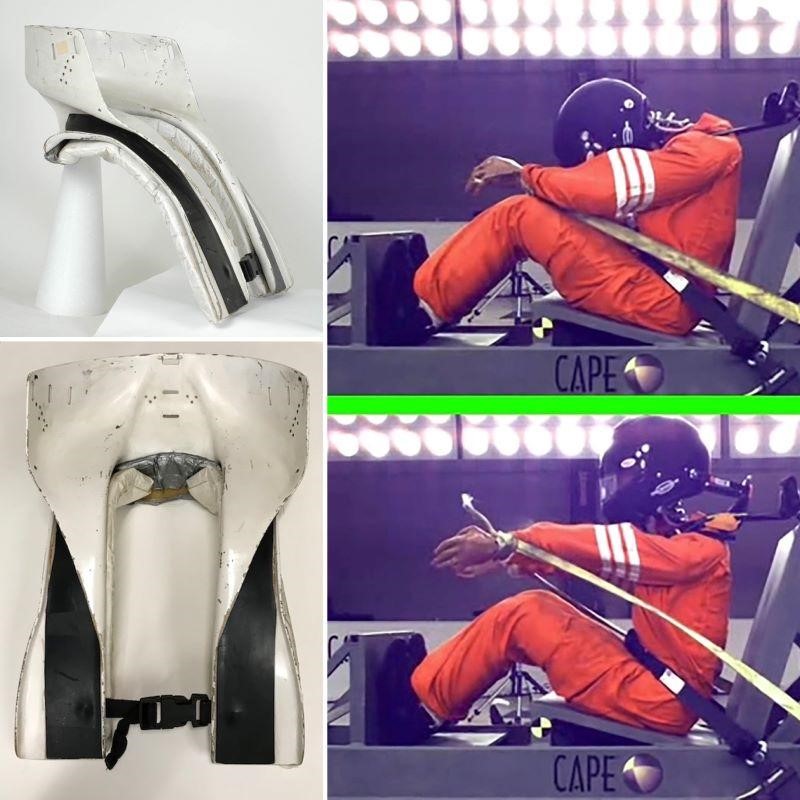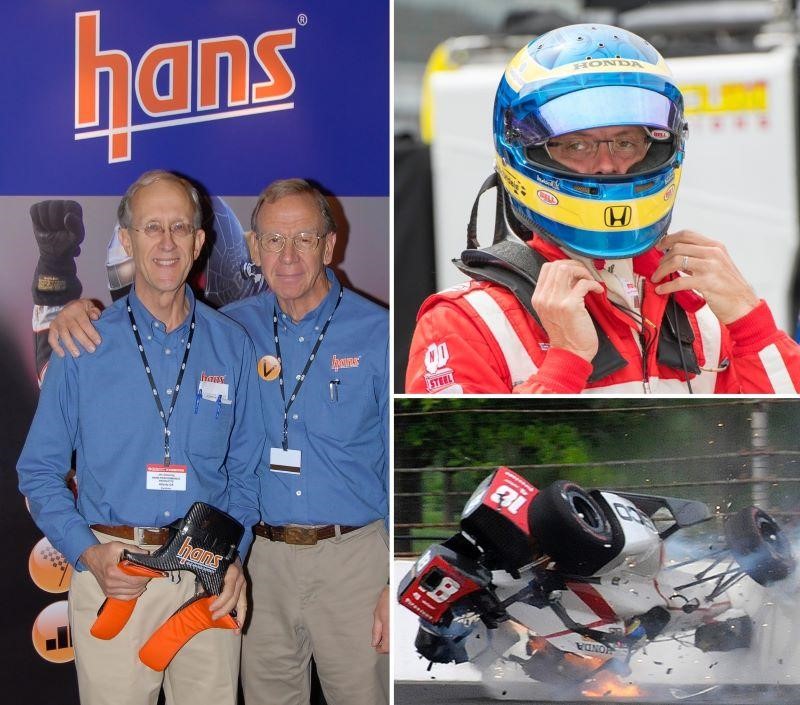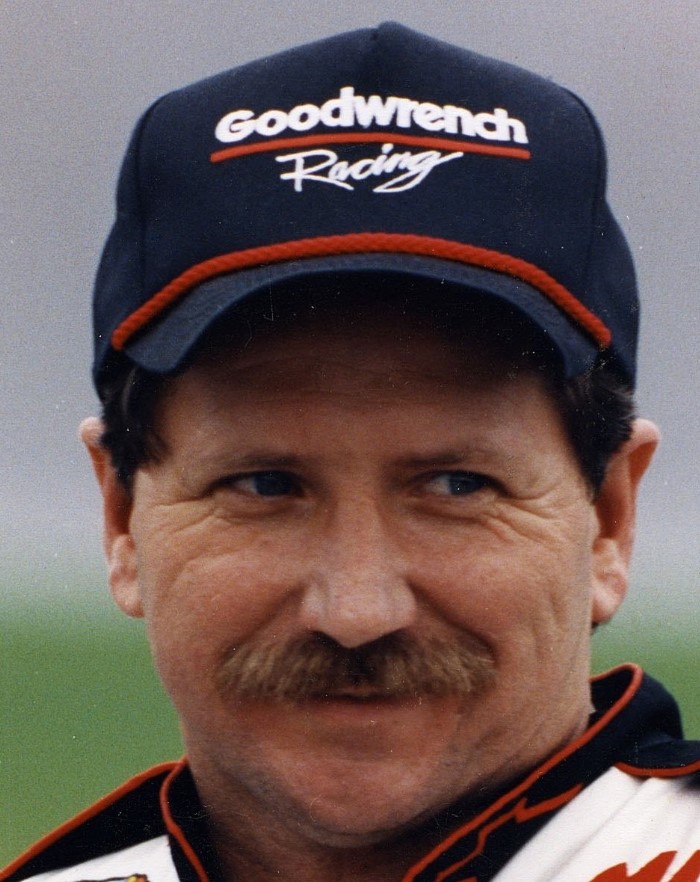First HANS Device Highlights new Motorsports Hall of Fame of America Safety Exhibit

The first HANS device worn in competition at Daytona 35 years ago highlights a new safety exhibit at the Motorsports Hall of Fame of America (MSHFA) on the grounds of Daytona International Speedway. The exhibit opens on the 20th anniversary of the first full seasons when CART Indy car and NASCAR Cup Series drivers were mandated to wear a HANS device.
Five-time IMSA champion Jim Downing competed for the first time wearing a prototype version in the October 1986 3-hour IMSA season finale at Daytona. The HANS (Head And Neck Support) was needed because of increased speeds and, ironically, superior cockpit restraints. Basal skull fractures resulted when safety harnesses held a driver’s torso in place and the energy of a sudden stop in a high-speed crash was transferred to a helmeted head, resulting in head whip and sometimes deadly neck tension.

It took more than a decade to persuade sanctioning bodies to mandate racing’s first head restraint. Following additional development to reduce its size, the HANS was mandated by CART (a predecessor to the current IndyCar Series) for ovals during the 2001 season. NASCAR followed in the fall of 2001 after a series of fatalities from basal skull fractures, including Dale Earnhardt in the 2001 Daytona 500.
“When the lightweight and smaller HANS came out, F1 and CART jumped on it,” said Dr. Stephen Olvey. “As Director of Medical Affairs for IndyCar, I had to find a driver who would test the device for an extended period. Christian Fittipaldi agreed to take on the challenge during the winter test.”

“CART made the HANS mandatory on all oval tracks in 2001,” continued Olvey. “NASCAR made the HANS mandatory in October of 2001 with another device they were testing called the Hutchens device. In 2002 CART made the HANS mandatory for all races. Formula 1 adopted the HANS in 2003 and NASCAR stopped using the Hutchens device in 2005. Now nearly every serious racing driver wears a HANS device and nearly all professional series have made it mandatory. The risk of basilar skull fracture has now essentially disappeared.“
“We were very sure it was a serious safety device,” said Downing, who had first suggested to Dr. Robert Hubbard that motor racing needed a way to reduce head injuries. Hubbard, who died in 2019, was Downing’s brother-in-law and a professor of biomechanical engineering at Michigan State University.
The HANS, needed in high-speed crashes even with SAFER barriers, eventually helped end basal skull fractures in major league racing. Among the believers is four-time NASCAR Cup Series champion Jeff Gordon.
When Gordon first met Hubbard in 2008, he shook the HANS inventor’s hand and told him, “I want to thank you for saving my life twice.” Earlier that year at Las Vegas Motor Speedway, Gordon’s Chevy hit a concrete wall in the infield head-on. The huge impact sent his radiator over a hundred yards up the track, but the Cup champion walked away thanks to his HANS. Gordon believes it also saved his life at Charlotte Motor Speedway in 2001, when he hit the outside wall head-on during NASCAR’s all-star race just three months after Earnhardt’s crash.
Boat racer Andy Anderson was the first to credit the HANS’ life-saving capacity following a violent crash in 1991 on board his ModVP tunnel boat that slammed into the water upside down in Bay City, Michigan. His HANS Model I absorbed enough energy to crack, but very likely saved him from fatal injury. “There was a lot of talk about whether the HANS was worth it, was it too cumbersome?” said Anderson, who adopted a HANS after the death of fellow boat racer Christopher “Red” Hindman. “I decided it was a safety issue and not a performance issue.”
The sport’s first head restraint did not meet with immediate acceptance or approval. Made of fiberglass and finished in white gelcoat, the device first worn by Downing at Daytona was dubbed the “Cinderella Collar.”
“The other racers were polite,” said Downing. “I’d won the Camel Lights championship two years in a row. But there was an array of strange stares and wry smiles.”
Sanctioning body mandates in series around the world as well as voluntary use in auto and boat racing eventually led to the production and sale of over 500,000 devices.
In addition to displaying the “Cinderella Collar,” the MSHFA exhibit chronicles the efforts of Hubbard and Downing to reduce the size of the HANS to make it universally applicable in all types of racing.
“We are grateful to Jim Downing and Jonathan Ingram, author of the book Crash! How the HANS Helped Save Auto Racing (2019) for making this exhibit possible,” said Motorsports Hall of Fame of America President George Levy. “Few devices in the history of the sport have contributed as much to saving lives.”
The “Cinderella Collar” was the first of the wraparound Model I devices. It was replaced by the carbon fiber Model I, which was dubbed the “Elvis Collar” in the IMSA paddock. Downing wore a HANS in every race following that 1986 debut including his LMP-2 class victory at Le Mans in 1996. But in the first 10 years after HANS Performance Products was launched by Hubbard and Downing in 1991, fewer than 300 were sold.
The two men recognized they needed to develop a smaller version. But it was not until a basal skull fracture nearly killed future two-time Formula 1 World Champion Mika Hakkinen at the 1995 Australian Grand Prix that an opportunity presented itself. Mercedes-Benz, which supplied engines to Hakkinen’s McLaren F1 team, stepped in and helped Hubbard create a smaller HANS that would fit in F1 cockpits.
The resulting HANS Model II was universal and could fit into all cockpits. Following a fatal basal skull fracture suffered by Gonzalo Rodriquez and the fatal crash of Greg Moore in 1999, CART’s Dr. Olvey helped persuade the sanctioning body to become the first to mandate the Model II on ovals in 2001. A little more than two months after Earnhardt’s death, CART driver Mauricio Gugelmin was saved from a fatal head injury by his HANS during a spectacular double-impact crash at the Texas Motor Speedway.
Preceded by three fatal head injuries in NASCAR during a span of 10 months, Earnhardt’s crash proved decisive. HANS Performance Products took orders for more HANS devices in a week than had been sold in the company’s first 10 years. After its investigation of Earnhardt’s crash, NASCAR decided to mandate head restraints for the 2002 Cup season. At about the same time, CART mandated the HANS for all its 2002 races, including street and road courses. Ironically, after foot-dragging by drivers and teams, F1 did not require drivers to wear a HANS until the outset of the 2003 season.
“It was a long struggle to gain acceptance for our head restraint,” said Downing. “But thanks to Bob Hubbard’s experience with safety testing for General Motors in the 1960s and his sled testing that proved a HANS would work without causing any unintended consequences, we finally succeeded. It was unfortunate how many drivers were lost to head or neck injuries in the time it took for a head restraint to gain acceptance.”
Another section of the MSHFA’s new safety exhibit pays tribute to 2003 inductee Bill Simpson. NASA astronaut and racing buff Pete Conrad had introduced Simpson to a fire-resistant DuPont fabric called Nomex in 1967. Soon, Simpson’s Nomex fire suits were being worn by drivers everywhere. In the exhibit is one of the actual suits in which Simpson famously set himself on fire to demonstrate their life-saving properties.
For more information, visit the MSHFA at www.mshf.com or contact Levy at (248) 895-1704 or glevy@mshf.com. For museum tickets call 1-800-PIT-SHOP.
The Motorsports Hall of Fame of America is on Facebook at www.facebook.com/MotorsportsHOF/ and Instagram and Twitter at @MotorsportsHOF.